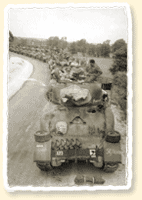

Allied tanks break out of Normandy to complete the liberation of Northern France, August 1944. |
The North West Europe Campaign, 1944-1945
After the German invasion of the Soviet Union in 1941, Joseph Stalin
repeatedly demanded that the western open a "Second Front" in
western Europe to relieve pressure on his Eastern Front, where the
Russian faced the Germans in brutal combat. He had to wait
until mid-1944.
On 15 August 1944, before
D-Day and the Normandy Campaign
were completed, the American Seventh landed on the French
Mediterranean coast and drove north to link up with the Allied
forces in Normandy. The Free French 2nd Armoured liberated
Paris on August 22. In the long campaign to drive the Germans
completely out of the territory it occupied and to invade Germany
itself, General Dwight D. Eisenhower, the Anglo-American Supreme
Commander, pursued a "broad front" strategy. All the Allied armies
advanced together, in order to employ their ever-increasing
superiority in matTriel both on the ground and in the air.
The First Canadian , commanding at various times American, British,
Czech and Polish formations who outnumbered the Canadians, fought along
the left flank of this advance, clearing or bypassing the Channel
ports, fighting heavily in the approaches to Antwerp and throughout
the Netherlands
( see The Liberation of the
Netherlands ). The final
months of the war saw the Canadians fighting within northern Germany
in the Rhineland and advancing to the North Sea. 1st Canadian
Parachute , a part of the British 6th and
operating away from the other Canadians, advanced the furthest into
Germany. It met the Russians advancing from the east at Wismer on
the Baltic Sea on 2 May 1945.
Related Newspaper Articles
English Articles
- These Anvil Blows
The Hamilton Spectator, 16/08/1944
- Canadians in Special Force That Took Riviera Islands
The Globe and Mail, 21/08/1944
- Paris Freed
The Hamilton Spectator, 23/08/1944
- Swift British Thrusts Northeast From Arras And Lille Have Freed Brussels
The Globe and Mail, 05/09/1944
- Stiff Fighting Through Winter Not Improbable
The Hamilton Spectator, 09/09/1944
- Canadians Clear Way for Antwerp
The Globe and Mail, 13/10/1944
- Lineup of Allied Armies Along Western Front
The Globe and Mail, 28/11/1944
- Battle for Germany: A Fortress Besieged
The New York Times, 17/12/1944
- Gives Astounding Display of Heroism in Hochwald Battle
The Hamilton Spectator, 13/03/1945
- Canadian Units Finally Reach End of Long Road
The Hamilton Spectator, 07/05/1945
French Articles
-
La 1ère armée canadienne avance maintenant vers l'est
Le Devoir, 18/08/1944
-
Des Belges et des Hollandais combattent avec les Canadiens
Le Devoir, 18/08/1944
-
Les troupes alliés sont dans Paris où la bataille continue.
Le Devoir, 24/08/1944
-
La première armée canadienne enfonce la ligne de la seine
Le Devoir, 26/08/1944
-
Les Canadiens à Thiberville
Le Devoir, 26/08/1944
-
Nouvelles de guerre. Toutes les armées canadiennes outre-mer se battent en Europe
Le Devoir, 28/08/1944
-
Les Canadiens sont entrés dans Rouen
Le Devoir, 31/08/1944
-
Les Canadiens se rapproche de Bruges
Le Devoir, 09/09/1944
-
Prise de Bourg-Léopold par les Britannique. Les Canadiens s'emparent de Dixmude
Le Devoir, 09/09/1944
-
03e victorieuse de Falaise à Boulogne
Le Devoir, 12/09/1944
-
Les Canadiens pratiquement maîtres de Boulogne
Le Devoir, 18/09/1944
-
Les Canadiens visitent Dieppe
Le Devoir, 18/09/1944
-
L'entrée des Canadiens dans Dieppe
Le Devoir, 18/09/1944
-
L'infanterie canadienne dans Boulogne
Le Devoir, 19/09/1944
-
L'assaut contre Calais se poursuit
Le Devoir, 29/09/1944
-
Les deux fronts d'Allemagne
Le Devoir, 09/11/1944
-
M. Churchill et la prise de l'escaut
Le Devoir, 09/11/1944
-
Les Alliés reprennent l'offensive en Belgique
Le Devoir, 19/12/1944
-
Les Alliés reprennent l'initiative en Belgique
Le Devoir, 28/12/1944
-
Plus d'un million d'Allemands se sont rendus au maréchal Montgomery
Le Devoir, 05/05/1945
|